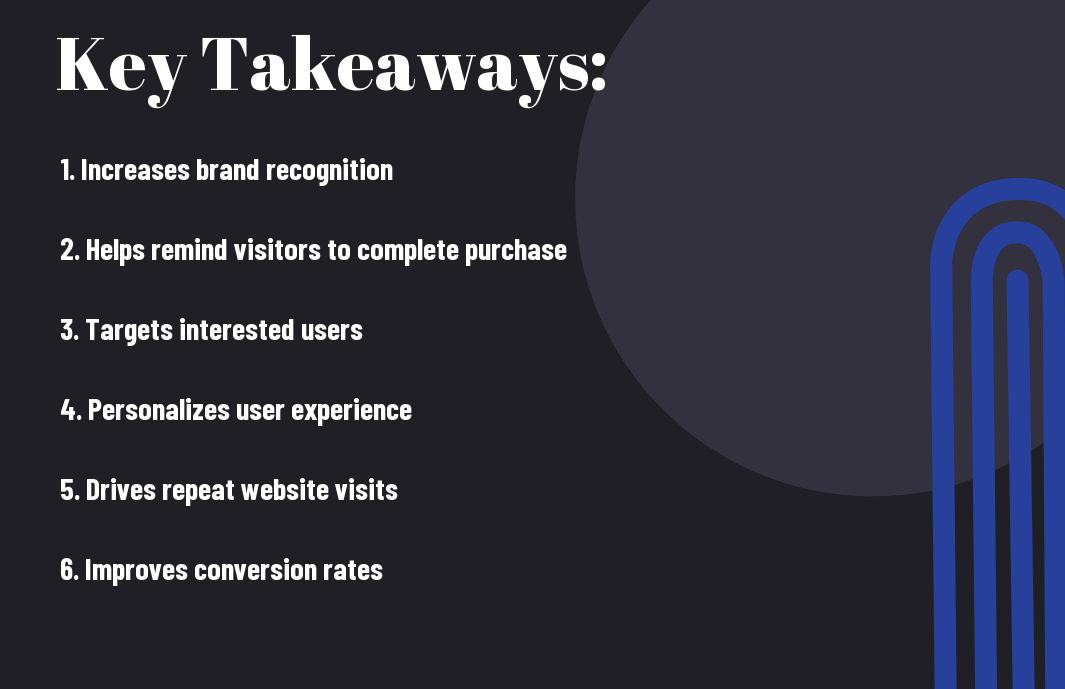There’s a powerful marketing strategy that can significantly increase your website’s conversion rates: retargeting ads. By strategically displaying personalized ads to users who have previously visited your website, you can stay top of mind and entice them to return and make a purchase. In this article, you’ll learn how retargeting ads work, why they are effective, and how you can implement them to convert more of your website visitors into satisfied customers.
Key Takeaways:
- Increased Conversion Rates: Retargeting ads remind website visitors of your products or services, keeping your brand top of mind and increasing the likelihood of conversion.
- Personalized Approach: These ads can be customized based on the visitor’s behavior on your site, targeting specific products or services they showed interest in, leading to a more personalized experience.
- Improved ROI: Retargeting ads are a cost-effective way to re-engage with potential customers who have already shown interest in your brand, leading to a higher return on investment compared to traditional advertising methods.
The Power of Retargeting Ads
What are Retargeting Ads?
While browsing the internet, you may have noticed that after visiting a website, ads from that site start following you around. These are retargeting ads – a powerful tool used by businesses to reconnect with visitors who didn’t make a purchase or complete a desired action on their website. By placing a simple piece of code on their site, companies can track your activity and show you targeted ads as you browse elsewhere online.
Why Do Website Visitors Leave Without Converting?
Powerful as they are, it’s a fact that not every visitor to your website will convert into a customer right away. There are various reasons why people leave without making a purchase or taking the desired action. It could be due to distractions, comparison shopping, or simply not being ready to commit. This is where retargeting ads come into play, giving you the chance to stay top of mind and gently nudge these potential customers back towards making a decision.
The key to successful retargeting is understanding the customer journey and providing relevant, personalized content to address their specific needs or concerns. By strategically showing ads that remind visitors of what they were interested in, you can increase the likelihood of them returning to your site and completing the desired action.
Identifying Valuable Website Visitors
There’s a wealth of valuable information you can gather from your website visitors to tailor your retargeting ads effectively. According to How retargeting campaigns help you reach 98% of your potential customers, understanding who your ideal customers are and what pages they visit on your website is crucial for converting them into actual customers.
Who are Your Ideal Customers?
For you to effectively convert website visitors into customers, it’s imperative to know who your ideal customers are. By analyzing data such as demographics, behavior patterns, and interests, you can create detailed customer personas. These personas will help you tailor your retargeting ads to reach the right audience, increasing the chances of conversion.
What Pages Do They Visit on Your Website?
Customers often visit specific pages on your website that indicate their level of interest in your products or services. By tracking the pages they frequent, such as product pages, pricing information, or contact pages, you can gain valuable insights into their intent. This information allows you to create retargeting ads that directly address their needs and concerns, nudging them towards making a purchase.
Setting Up Effective Retargeting Campaigns
Despite having the right intent and data, setting up effective retargeting campaigns can be a daunting task. To help you navigate this process, it’s crucial to pay attention to two key elements: choosing the right retargeting platform and creating compelling ad creative.
Choosing the Right Retargeting Platform
Any successful retargeting campaign starts with selecting the right platform that aligns with your goals and target audience. With a plethora of options available, ranging from Google Ads to social media platforms like Facebook and Instagram, you must choose the platform that best suits your business. Different platforms offer varying capabilities, such as dynamic product ads or personalized recommendations, so it’s necessary to align your objectives with the platform’s strengths.
Creating Compelling Ad Creative
Compelling ad creative is the heart of any retargeting campaign. Your ad content needs to resonate with your potential customers and entice them to revisit your website. Consider crafting personalized messages that address the specific needs or pain points of your audience. Visual elements such as eye-catching images or videos can also significantly impact the success of your campaign. Note, the goal is to make your ads stand out and inspire action from your audience.
The imagery and messaging in your ads should be consistent with your brand identity and values. By maintaining a cohesive look and feel across all ad creatives, you can reinforce brand recognition and trust with your audience. Additionally, A/B testing different ad variations can help you identify which creatives perform best and optimize your campaigns for better results.

Targeting Strategies for Maximum Impact
Behavioral Targeting: Reach Users Based on Actions
Maximum impact in retargeting ads comes from understanding your website visitors’ behavior. By tracking their actions on your site, such as the pages they visit, products they view, or items they add to their cart but don’t purchase, you can tailor your retargeting ads to remind them of their interests and encourage them to complete the desired action.
Demographic Targeting: Reach Users Based on Characteristics
Reach users based on their demographic information, such as age, gender, location, and interests. This allows you to create highly targeted retargeting ads that resonate with specific audience segments. By analyzing the characteristics of your website visitors, you can personalize your ad content to better appeal to their preferences and increase the likelihood of conversions.
This targeted approach helps you create more relevant and engaging ad campaigns that speak directly to the needs and interests of different user groups. By segmenting your audience based on demographics, you can deliver personalized messages that are more likely to capture their attention and drive them to take action on your site.
Measuring and Optimizing Retargeting Ad Performance
Key Metrics to Track for Retargeting Success
To ensure the success of your retargeting ads, it’s crucial to track key metrics that indicate how well your campaigns are performing. Some necessary metrics to monitor include click-through rates (CTR), conversion rates, cost per acquisition (CPA), and return on ad spend (ROAS). By analyzing these metrics, you can identify which ads are driving the most engagement and conversions, allowing you to optimize your retargeting strategy for better results.
A/B Testing for Continuous Improvement
Success in retargeting ads often hinges on continuous improvement through A/B testing. By running A/B tests on different ad creatives, messages, or target audiences, you can identify what resonates best with your audience and refine your campaigns accordingly. This iterative process allows you to optimize your ads for higher performance over time, ultimately leading to increased conversions and ROI.
Through A/B testing, you can uncover valuable insights about your target audience’s preferences and behavior, enabling you to tailor your retargeting ads for maximum impact. By testing and refining your ad elements based on real data, you can ensure that your campaigns are always evolving to meet the changing needs and expectations of your potential customers.

Common Mistakes to Avoid in Retargeting Ads
Many businesses make errors in their retargeting ad strategies that can hinder their effectiveness. These mistakes can result in wasted ad spend and even drive potential customers away. Here are some common pitfalls to steer clear of when running retargeting campaigns.
Over-Retargeting: Don’t Annoy Your Visitors
To begin with, bombarding your website visitors with a high frequency of retargeting ads can lead to ad fatigue and annoyance. While it’s important to stay top of mind, showing your ads too frequently can have the opposite effect and turn potential customers off. Be strategic in your approach by setting frequency caps and carefully monitoring the number of times an individual sees your ad within a specific timeframe.
Under-Retargeting: Don’t Miss Opportunities
Any visitor who has engaged with your website has shown some level of interest in your products or services. Therefore, failing to retarget these individuals means missing out on valuable opportunities to convert them into customers. Ensure you have a comprehensive retargeting strategy in place that targets different segments of your website visitors based on their level of interaction and behavior.
For instance, visitors who abandoned their shopping carts should be targeted with specific ads encouraging them to complete their purchase. On the other hand, those who have browsed multiple product pages but haven’t made a purchase could be retargeted with ads showcasing popular products or special promotions.

To wrap up
Conclusively, retargeting ads serve as a powerful tool to convert website visitors into customers by reminding them of your products or services and effectively guiding them back to your site for a purchase. By strategically placing these ads in front of individuals who have already shown interest in your offerings, you can significantly increase your chances of closing a sale. Remember to tailor your messaging and offers to entice potential customers and keep your brand top of mind as they navigate through their online journey.
Q: How can retargeting ads help convert website visitors into customers?
A: Retargeting ads can help convert website visitors into customers by showing personalized ads to users who have already visited your website. These ads remind users of your products or services, keeping your brand top of mind and encouraging them to return and make a purchase.
Q: What are the benefits of using retargeting ads for conversion?
A: Retargeting ads can increase conversion rates by reaching users who have shown interest in your products or services. By targeting these engaged visitors with relevant ads, you can encourage them to come back to your site and complete a desired action, such as making a purchase or signing up for a newsletter.
Q: How can I set up retargeting ads to convert website visitors into customers?
A: To set up retargeting ads, you can use tools like Facebook Pixel, Google Ads Remarketing, or other retargeting platforms to track website visitors and display personalized ads to them across the web. By creating compelling ad creatives and targeting specific audience segments, you can effectively engage with past visitors and guide them towards conversion.
